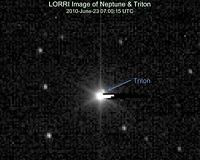 |
Sydney, Australia (SPX) Sep 08, 2010 The New Horizons spacecraft, launched in 2006, is more than halfway to Pluto, a mysterious world that's been the subject of so much controversy in recent years. The debate over Pluto's status as a planet is just the most visible example of a huge new arena of discovery that's taking place in astronomy. Pluto is the most famous resident of the Kuiper Belt. This is part of a region of space beyond the orbit of Neptune that has yielded many secrets over the past two decades, long after most people thought that we knew our own solar system pretty well. Outside the Kuiper Belt lurk other mysteries and other worlds that also tempt our curiosity. The Kuiper Belt and the regions around it are known to include at least eight fairly large "Trans-Neptunian Objects", a somewhat politically correct term that dodges the politics of calling things "planets" or "minor planets". Pluto is not even the largest of these! Eris, a world discovered in 2003, is even larger. It orbit lies outside the normal boundaries of the Kuiper belt, but it's still on the fringe of the solar system. Other large Trans-Neptunian Objects include Sedna, Quaoar, Makemake, Haumea, Varuna and Orcus. The list grows longer as smaller worlds are added. Gradually, new discoveries are adding to the tally. It's like a strange new solar system just beyond the boundaries of our normal neighbourhood of planets. Three spacecraft have crossed into the domain of the Trans-Neptunian Objects. They are Pioneers 10 and 11, and Voyager 2. None of these missions encountered any TNOs. The spacecraft were flying on greatly extended missions, having visited the outer planets, and most of the TNOs we know today weren't even discovered when these spacecraft were launched. New Horizons marks the first dedicated mission to a TNO, and will probably explore more worlds than Pluto. The spacecraft should still be healthy after New Horizons flies past Pluto and its three moons in 2015, and controllers hope to steer it towards another encounter with an object. At the moment, nobody really knows where New Horizons will go after its main encounter. It will probably be targeted at a world that is currently not even known to exist! New Horizons will teach us much about this generally unexplored region of space, but it should be regarded as just the first step in our quest to understand the TNOs. It's not too early to begin considering the missions that should follow in its wake. At the very least, other major TNOs such as Eris should be targeted. Smaller worlds could also yield different insights into the deep space environment, and the history of the solar system. There's talk among space planers of developing huge boosters in the future, larger than our current fleet of rockets. Some are proposed by private enterprise, others come from government panels. While these rockets would mostly be used for sending huge things to near-Earth space, they would clearly have potential for reaching the outer solar system. We could send larger spacecraft, with more capabilities than New Horizons, to the TNOs. Alternatively, a single launch could send a pair or a small cluster of near-identical spacecraft, which would fan out to explore different regions beyond Neptune. A cluster mission would also allow the spacecraft to interact with each other on the long flight through deep space. Transmissions between the craft could probe the properties of interplanetary space in ways not previously performed, and explore how subtle changes in particles and fields appear over the course of the flight. Our first close look at Pluto will probably raise more questions than it answers, and we will want our new questions resolved. The instruments chosen for future missions will probably have much in common with New Horizons, such as cameras and spectrometers. But we could find that our lines of investigation become more focused after New Horizons, leading to payloads that would not have been considered before. We probably won't see another mission launched beyond Neptune for several years. By then, advances in miniaturization will also lead to better spacecraft that are lighter, stronger, and less demanding on power sources. New Horizons is a highly advanced spacecraft that has faced severe challenges to its weight and power demands, but its successors will almost certainly be even better. In the meantime, astronomers will continue to scan the skies, and will probably find even more out there than we currently know about. Between our impending close look at Pluto, and our ongoing surveys from a distance, the mysteries of worlds beyond Neptune will tempt us for years to come. Dr Morris Jones is an Australian space analyst ands writer. Email morrisjonesNOSPAMhotmail.com. Replace NOSPAM with @ to send email.
Share This Article With Planet Earth
Related Links New Horizons The million outer planets of a star called Sol
 Picture-Perfect Pluto Practice
Picture-Perfect Pluto PracticeLaurel MD (SPX) Sep 06, 2010 Neptune's giant moon Triton is often called Pluto's "twin" - so what better practice target, then, for New Horizons' telescopic camera? New Horizons' Long Range Reconnaissance Imager (LORRI) snapped several photos of Neptune during the latest annual systems checkout, which ended July 30. Neptune was 23.2 astronomical units (about 2.15 billion miles!) from New Horizons when LORRI took aim a ... read more |
|
| The content herein, unless otherwise known to be public domain, are Copyright 1995-2010 - SpaceDaily. AFP and UPI Wire Stories are copyright Agence France-Presse and United Press International. ESA Portal Reports are copyright European Space Agency. All NASA sourced material is public domain. Additional copyrights may apply in whole or part to other bona fide parties. Advertising does not imply endorsement,agreement or approval of any opinions, statements or information provided by SpaceDaily on any Web page published or hosted by SpaceDaily. Privacy Statement |